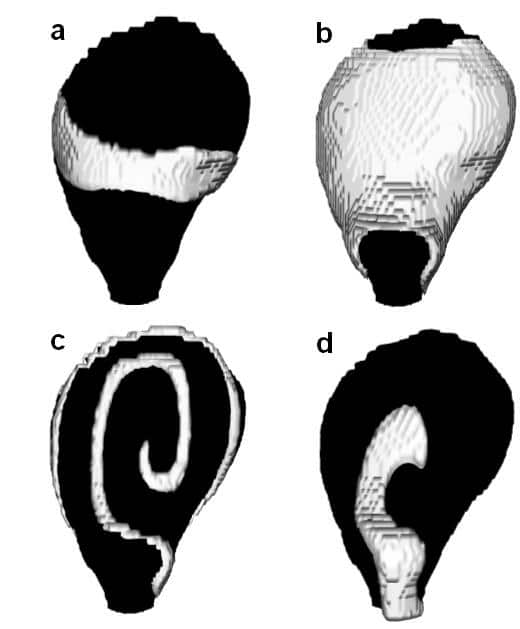Effective labour requires synchronous uterine contractions. Synchronisation in the electrical excitation in the gravid uterus can be inferred by non-invasive electromyography (Simpson et al. 1998) or spatio-temporal magneto-myography (Ramon et al. 2005). We have constructed a 3-D model of the myometrial wall of the third trimester gravid human uterus, with geometry from magnetic resonance image data, with a simplified (FitzHugh-Nagumo) model for excitation. Propagation is modelled by a reaction diffusion equation, with a diffusion coefficient D, dimensions of distance2 time-1, that describes the diffusive spread of excitation in space (Winfree, 1991). An increase in D simulates the increased inter-cellular coupling produced by upregulation of connexin-43 (Cx-43) in phase 1 of parturition. The increase in Cx-43 can be modelled by a linearly scaled increase in D. A solitary excitation wave has a wavelength λ that is the product of its duration and velocity. The velocity is proportional to √D. An irregular spatial distribution in parameters allows spatiotemporal-irregularity in activity, which can produce near synchronous excitation. For a homogeneous myometrium, near synchronous excitation could be produced by a single, excitation wave, with a λ ~ size of the uterus (Fig. 1b), or by repeated excitation by re-entrant waves with λ less than uterine size (Fig. 1c). A pair of such re-entrant waves can be initiated by a localised perturbation occuring in the vulnerable window of a preceeding propagating wave. Smooth, spatial gradients in excitation or coupling parameters produce slow drift of re-entrant waves, which lead to self-termination of re-entrant waves by moving their cores to a boundary (Biktashev & Holden, 1999). Persistent re-entrant excitation can occur if drift leads to a single re-entrant wave pinned at the cervix (Fig. 1d). Wave effects – long wavelength, re-entry, or spatio-temporal irregularity – can all contribute to the spatio-temporal synchronisation of excitation necessary for uterine contractions.
University College London 2006 (2006) Proc Physiol Soc 3, PC210
Poster Communications: Modelling the effects of diffusive coupling on spatio-temporal excitation patterns in the gravid human uterus
Arun V Holden1, Pan Li1, Nigel AB Simpson2
1. Institute of Membrane and Systems Biology, University of Leeds, Leeds, United Kingdom. 2. Obstetrics and Gynaecology, University of Leeds, Leeds, United Kingdom.
View other abstracts by:
Figure 1. Anterior view of computed excitation wave patterns on gravid uterus white is excitation. a (D= 0.03) b (D=0.16) solitary circular waves initiated at the fundus; c pair of re-entrant spiral waves (0.01) and d (D=0.05) solitary broken wave pinned to the cervix.
Where applicable, experiments conform with Society ethical requirements.

